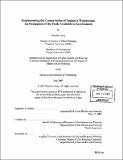| dc.contributor.advisor | John P. de Monchaux. | en_US |
| dc.contributor.author | Jiang, Zhanbin, 1973- | en_US |
| dc.contributor.other | Massachusetts Institute of Technology. Dept. of Urban Studies and Planning. | en_US |
| dc.coverage.spatial | a-cc--- | en_US |
| dc.date.accessioned | 2011-12-09T21:22:24Z | |
| dc.date.available | 2011-12-09T21:22:24Z | |
| dc.date.copyright | 2003 | en_US |
| dc.date.issued | 2003 | en_US |
| dc.identifier.uri | http://hdl.handle.net/1721.1/67550 | |
| dc.description | Thesis (M.C.P.)--Massachusetts Institute of Technology, Dept. of Urban Studies and Planning, 2003. | en_US |
| dc.description | Includes bibliographical references (p. 77-78). | en_US |
| dc.description.abstract | Suzhou's waterscape, noted for its "small bridges over flowing streams, residences on canal banks," is a historic relic that the Suzhou government has decided to conserve. In implementing the conservation of Suzhou's waterscape, the government needs to place priority on three goals: conservation of the physical environment, improvement of the water quality in the canals, and maintenance of the quality of life for its residents. The Suzhou government has instituted different strategies to carry out its conservation projects and the results have been mixed. The conservation approach traditionally practiced in China's central-planned economy does not take into account market forces which have surfaced in China's transitional economy. This thesis proposes that adopting and modifying government tools generally used in western economies to Suzhou is necessary to ensure successful conservation of Suzhou's waterscape. In addition, a formal assessment of government tools should be carried out. Furthermore, constraints that inhibit the availability of government tools should be relaxed. Finally, this thesis recommends four conservation approaches specifically targeted to Suzhou's waterscape and puts forward a new government paradigm in which more non-governmental actors such as non-profit organizations and private individuals would participate in a democratic manner and in which social equity would be a core consideration. | en_US |
| dc.description.statementofresponsibility | by Zhanbin Jiang. | en_US |
| dc.format.extent | 78 p. | en_US |
| dc.language.iso | eng | en_US |
| dc.publisher | Massachusetts Institute of Technology | en_US |
| dc.rights | M.I.T. theses are protected by
copyright. They may be viewed from this source for any purpose, but
reproduction or distribution in any format is prohibited without written
permission. See provided URL for inquiries about permission. | en_US |
| dc.rights.uri | http://dspace.mit.edu/handle/1721.1/7582 | en_US |
| dc.subject | Urban Studies and Planning. | en_US |
| dc.title | Implementing the conservation of Suzhou's waterscape : an evaluation of the tools available to government | en_US |
| dc.type | Thesis | en_US |
| dc.description.degree | M.C.P. | en_US |
| dc.contributor.department | Massachusetts Institute of Technology. Department of Urban Studies and Planning | |
| dc.identifier.oclc | 52967710 | en_US |
